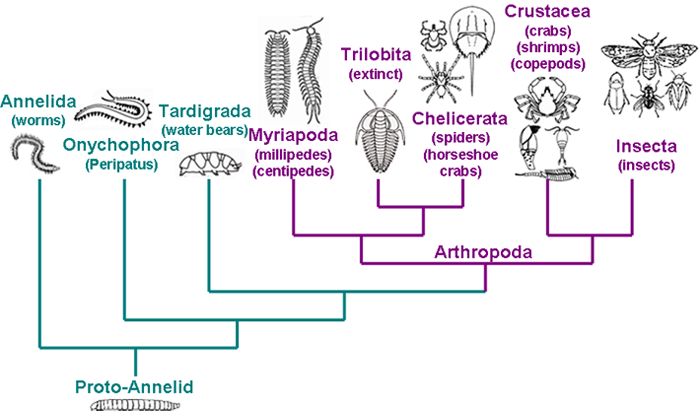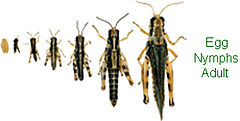| Eco Bites |
 |
|
The Insect World |
 |
|
The animal kingdom has 36 groups called
phyla; one of these, the phylum
Arthropoda, is of interest to us.
Arthropoda – the word means “jointed
legs” – all have exterior skeletons and
bodies consisting of a head and a
varying number of segments behind the
head, some or all of these segments have
a pair of appendages. |
|
The Arthropoda rose from primitive
segmented worms known as annelids when a
pair of appendages developed on each
body segment. In the more advanced
arthropods the rear segments lost their
appendages, only a few pairs on the
anterior segments remain. In these
advanced arthropods some of the segments
are often fused to form a single body
unit. |
|
A living remnant of the ancestral
arthropod is Peripatus, a primitive
animal found mostly in forest debris. |
|
|
 |
|
The insect family tree |
|
Looking at the family tree of the
original proto-annelid (below), one can see how
the Arthropoda branched off. The class
Insecta contains some of the most
advanced arthropods, they are
characterised by having 3 pairs of legs,
and many have developed wings enabling
them to fly, the only invertebrate that
has the ability of true flight.
Interesting to note on the family tree
is that insects are much closer related
to the Crustacea (crabs, shrimps, etc)
than the Chelicerata (spiders, ticks,
etc). |
 |
|
Insect bodies are typically divided into
a head containing sensory organs
(compound eyes & antennae) and
mouthparts; a thorax of 3 segments
(fused in more advanced insects) with
the three pairs of legs and two pairs of
wings (in adults only if present); and
an abdomen with a varying number of
segments and, in the adults, the
reproductive organs at the end. |
|
The word insect comes from the Latin
“insectum” meaning “with a notched or
divided body”; the word was first used
in the early 1600’s. Originally the
class Insecta was named Hexapoda
(meaning six-legged), but Hexapoda is
now the subphylum containing the Insecta
and 3 six-legged wingless groups
originally placed with the insects in
one class. |
 |
|
The history of insect development |
|
Insects are a very old group of animals
on earth, probably developing about 450
million years ago. The first trilobites,
a primitive arthropod now extinct,
appear in the fossil record about 500
million years ago; and by 300 million
years ago insects were already
well-developed. By the time the
dinosaurs appeared some 225 million
years ago, most of the insect groups we
know today were already present. An
important exception are the butterflies,
moths, bees, wasps, etc – all those
dependent on flowering plants – they
only developed after flowering plants
appeared 130 million years ago.
The fact is that for the last 100
million years, since long before mammals
became the dominant species, insects
have remained relatively unchanged
(below left). |
|
|
|
If one considers the number of animal
and plant species on earth (above right), insects are
without doubt the dominant group. Of the
total approximately 1,8 million
described non-bacterial species, insects
number over 1 million, or more than 56%.
Other invertebrates and plants total
just over 20% each; the remaining 3.3%
include all the other groups. |
|
Insects have thus been hugely successful
in colonising the earth, and are found
in just about every single available
habitat. They have also proved extremely
adaptable, adapting to changing
conditions much faster than other
organisms; thus enabling themselves to
flourish under conditions that have
caused the extinction of many other
animals or plants. |
 |
|
Classifying insects |
|
The class Insecta is divided into
Orders. These orders are subdivided into
three groups – from the most primitive to the
most advanced. |
| Apterygota
(Wingless insects with no true
metamorphosis) |
| Thysanura |
Silverfish, fish-moths |
 |
| *Diplura |
2-pronged bristletails |
| *Protura |
Proturans, coneheads |
| *Collembola |
Springtails |
| *Some
taxonomists now place these orders
in classes of their own. |
|
|
The Apterygota are wingless insects with
no true metamorphosis - after hatching
each instar will moult into a larger one
until it finally moults into a sexually
mature adult. There could be up to 30 or
40 instars. |
 |
| Exopterygota
(Undergoing partial
metamorphosis) |
| Ephemeroptera |
May-flies |
 |
| Odonata |
Dragonflies & damselflies |
| Plecoptera |
Stone-flies |
| Notoptera |
Rock crawlers |
| Orthoptera |
Grasshoppers |
| Phasmida |
Stick insects |
| Dermaptera |
Earwigs |
| Embioptera |
Web spinners |
| Dictyoptera |
Roaches and mantids |
| Isoptera |
Termites |
| Zoraptera |
Zorapterans, angel insects |
| Psocoptera |
Book lice & bark lice |
| Mallophaga |
Biting lice |
| Siphunculata |
Sucking lice |
| Hemiptera |
True bugs |
| Thysanoptera |
Thrips |
|
|
The Exopterygota undergo partial
metamorphosis - wings develop in those
that have flight, sexual organs develop
and in man species there are also a
change in the mouthparts if the diet of
the adults is different to that of the
nymphs. The nymphs hatch out of the eggs
and moult regularly into a larger nymph
- in some species there could be more
than 30 such moults before the final
moult into the adult. |
 |
|
Endopterygota (With complete
metamorphosis) |
|
Neuroptera |
Lacewings |
 |
| Mecoptera |
Scorpion flies |
| Siphonaptera |
Fleas |
| Trichoptera |
Caddis-flies |
| Strepsiptera |
Stylops |
| Coleoptera |
Beetles |
| Lepidoptera |
Butterflies & moths |
| Hymenoptera |
Ants, bees & wasps |
| Diptera |
True flies |
|
|
The Endopterygota undergo complete
metamorphosis, so much so that in many
cases adults and larvae were first
described as separate species. A larva,
usually wormlike, will develop from the
egg; the larva will go through several
moults before turning into a pupa -
during the pupal stage metamorphosis
from the larval form to the adult form
takes place. A complete adult will
emerge from the pupa. |
 |
|
Of the 1 million insect species, 79.5%
are in the last four orders in the table
– the Coleoptera, Lepidoptera,
Hymenoptera and Diptera. The Coleoptera
has the most species, about 400,000 – it
is the single largest order of animals
or plants on earth. |
|
Insects are the most successful animal
class on earth - in every conceivable
habitat one or more species flourish;
and they have been doing so for millions
of years. Insects are also very
adaptable and have easily adapted to
changes in their environment caused by
man; due to rapid generational cycles,
their adaptation has been much faster
than other animals or plants. |
 |
|
»
Click here to read more about insects
found in wetlands. |
 |
|
Compiled by Niel van Wyk from various sources |
 |